Influence of the Phosphor Layer Composition on Flexible Electroluminescent Device Performance
Abstract
1. Introduction
- −
- The back electrode is a highly conductive, low-resistance layer in direct contact with the substrate surface or interface layer, ensuring efficient current flow;
- −
- The busbar is a conductive layer that must be applied to the extremities to provide an optimal path for current distribution. This leads to maximum illuminance, making it a crucial element that should not be overlooked;
- −
- The dielectric layer is an excellent electrical insulator that polarizes when exposed to an electric field. This polarization results in a highly conducive environment for light emission;
- −
- Phosphor is a luminescent material responsible for light emission when excited by an electric field.
- −
- The front electrode is a translucent conductive material that allows the electrical current to be evenly distributed, resulting in a uniform light output.
2. Materials and Methods
2.1. Materials
2.2. Methods
3. Results
3.1. Characterization by Scanning Electron Microscopy
3.2. Illuminance Measurements
3.2.1. Performance Evaluation of the Samples
3.2.2. Performance Evaluation of the Developed Samples
3.2.3. Performance Evaluation during the Device’s Lifetime
4. Discussion
5. Conclusions
Author Contributions
Funding
Institutional Review Board Statement
Informed Consent Statement
Data Availability Statement
Acknowledgments
Conflicts of Interest
References
- Kathirgamanathan, P.; Bushby, L.M.; Kumaraverl, M.; Ravichandran, S.; Surendrakumar, S. Electroluminescent Organic and Quantum Dot LEDs: The State of the Art. J. Disp. Technol. 2015, 11, 480–493. [Google Scholar] [CrossRef]
- Fernández, M.R.; Casanova, E.Z.; Alonso, I.G. Review of Display Technologies Focusing on Power Consumption. Sustainability 2015, 7, 10854–10875. [Google Scholar] [CrossRef]
- Zhang, X.; Wang, F. Recent advances in flexible alternating current electroluminescent devices. APL Mater. 2021, 9, 030701. [Google Scholar] [CrossRef]
- Chansri, P.; Arunrungrusmi, S.; Yuji, T.; Mungkung, N. An Analysis of ZnS:Cu Phosphor Layer Thickness Influence on Electroluminescence Device Performances. Int. J. Photoenergy 2017, 2017, 4. [Google Scholar] [CrossRef]
- Kooroshnia, M.; Dumitrescu, D.; Lewis, E.; Walters, K. The colour, texture, and luminance: Textile design methods for printing with electroluminescent inks. Cult. Sci. Color.-Color Cult. Sci. J. 2023, 15, 27–34. [Google Scholar]
- Janczak, D.; Zych, M.; Raczyński, T.; Dybowska-Sarapuk, Ł.; Pepłowski, A.; Krzemiński, J.; Sosna-Głębska, A.; Znajdek, K.; Sibiński, M.; Jakubowska, M. Stretchable and Washable Electroluminescent Display Screen-Printed on Textile. Nanomaterials 2019, 9, 1276. [Google Scholar] [CrossRef] [PubMed]
- Graßmann, C.; Grethe, T.; Van Langenhove, L.; Schwarz-Pfeiffer, A. Digital printing of electroluminescent devices on textile substrates. J. Eng. Fibers Fabr. 2019, 14, 1558925019861624. [Google Scholar] [CrossRef]
- Wang, L.; Xiao, L.; Gu, H.S.; Sun, H.D. Advances in Alternating Current Electroluminescent Devices. Adv. Opt. Mater. 2019, 7, 1801154. [Google Scholar] [CrossRef]
- Zhang, Y.; Wang, X.; Zhang, Y.; Liu, M.; Zhao, Z.; Shen, Z.; Hu, Y. Wearable Alternating Current Electroluminescent e-Textiles with High Brightness Enabled by Fully Sprayed Layer-by-Layer Assembly. Adv. Funct. Mater. 2024, 34, 2308969. [Google Scholar] [CrossRef]
- Verboven, I.; Deferme, W. Printing of flexible light emitting devices: A review on different technologies and devices, printing technologies and state-of-the-art applications and future prospects. Prog. Mater. Sci. 2020, 118, 100760. [Google Scholar] [CrossRef]
- Hu, B.; Li, D.; Ala, O.; Manandhar, P.; Fan, Q.; Kasilingam, D.; Calvert, P.D. Textile-Based Flexible Electroluminescent Devices. Adv. Funct. Mater. 2011, 21, 305–311. [Google Scholar] [CrossRef]
- Lumilor Basics and FAQ. Available online: https://support.lumilor.com/lumilor/lumilor-basics-and-faq#properties-of-lumilor-3 (accessed on 22 January 2023).
- Park, B.J.; Seo, H.S.; Ahn, J.T.; Song, J.H.; Chung, W.J.; Jeon, D.Y. An investigation on photoluminescence and AC powder electroluminescence of ZnS:Cu,Cl,Mn,Te phosphor. J. Mater. Res. 2011, 26, 2394–2399. [Google Scholar] [CrossRef]
- Withnall, R.; Silver, J.; Harris, P.G.; Ireland, T.G.; Marsh, P.J. AC powder electroluminescent displays. Soc. Inf. Disp. J. 2011, 19, 798–810. [Google Scholar] [CrossRef]
- Polícia, R.; Correia, D.M.; Peřinka, N.; Tubio, C.R.; Lanceros-Méndez, S. Influence of polymer matrix on the luminescence of phosphor based printable electroluminescent materials and devices. Polymer 2023, 268, 125700. [Google Scholar] [CrossRef]
- Fadavieslam, M.R. The effect of thickness of light emitting layer on physical properties of OLED devices. Optik 2019, 182, 452–457. [Google Scholar] [CrossRef]
- Mi, H.; Zhong, L.; Tang, X.; Xu, P.; Liu, X.; Luo, T.; Jiang, X. Electroluminescent Fabric Woven by Ultrastretchable Fibers for Arbitrarily Controllable Pattern Display. ACS Appl. Mater. Interfaces 2021, 13, 11260–11267. [Google Scholar] [CrossRef]
- Sloma, M.; Janczak, D.; Wroblewski, G.; Mlozniak, A.; Jakubowska, M. Electroluminescent structures printed on paper and textile elastic substrates. Circuit World 2014, 40, 13–16. [Google Scholar] [CrossRef]
- Payne, S.; Moore, J. Preparation of Cross Sections of Difficult Materials for SEM Imaging. Microsc. Today 2018, 26, 40–45. [Google Scholar] [CrossRef][Green Version]
- Marques dos Anjos, P.N. Analysis of electroluminescence degradation for organic light-emitting diode using a rate equation of chemical kinetics. J. Inf. Disp. 2013, 14, 115–120. [Google Scholar] [CrossRef]
- Bochkov, Y.V.; Georgobiani, A.N.; Chilaya, G.S. Electroluminescence and Some Electrical Properties of Homogeneous Zinc Sulfide Single Crystals. In Electroluminescence/Elektrolyuminestsentsiya/Электрoлюминесценция; The Lebedev Physics Institute Series; Springer: Boston, MA, USA, 1972; Volume 50. [Google Scholar] [CrossRef]
- Lee, W.; Lyu, H.K.; Cho, H.S.; Lee, S.E.; Choi, B. Brightness enhancement of a direct-current-driven electroluminescent device prepared with zinc-sulfide powder. J. Lumin. 2020, 220, 117015. [Google Scholar] [CrossRef]

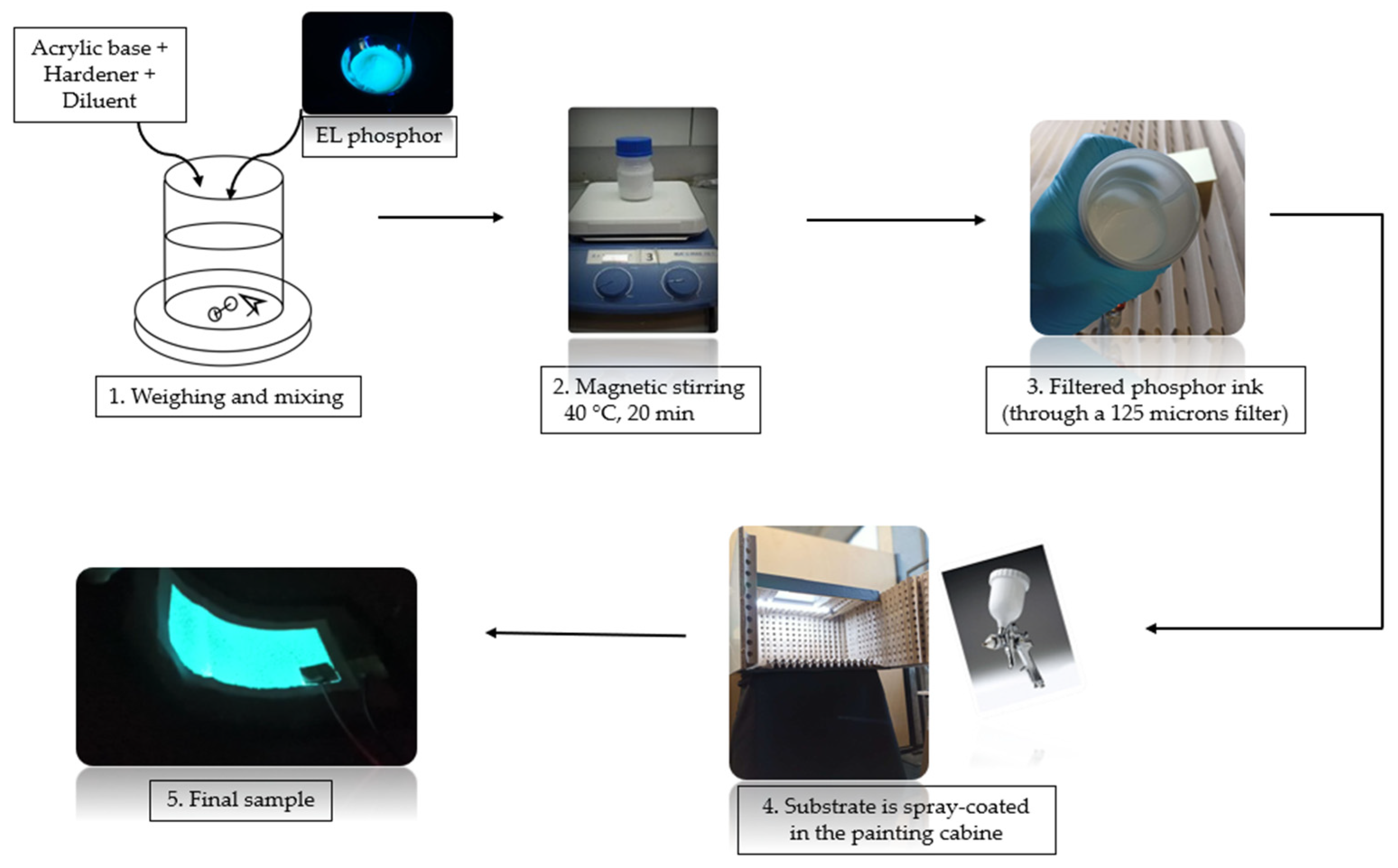
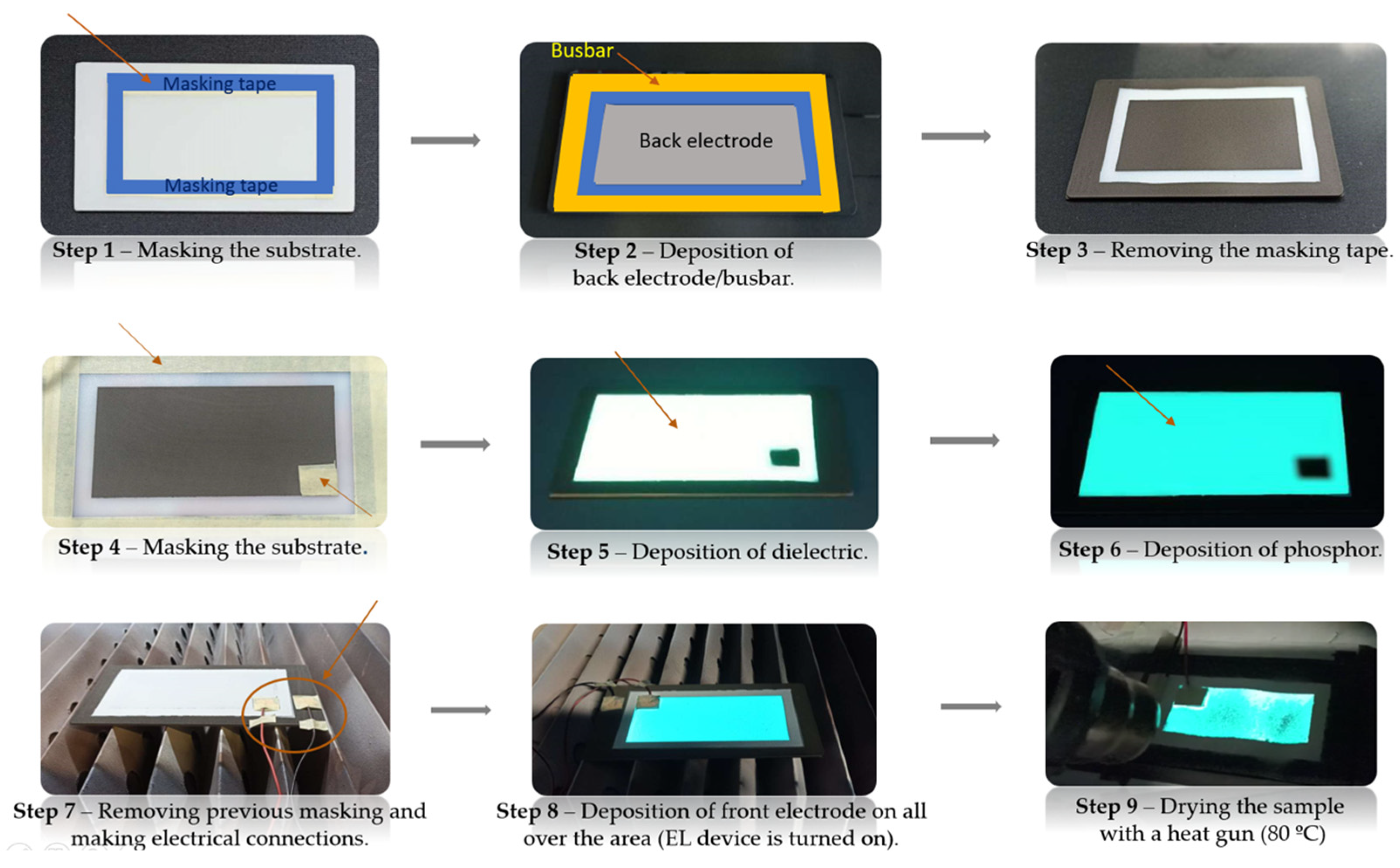

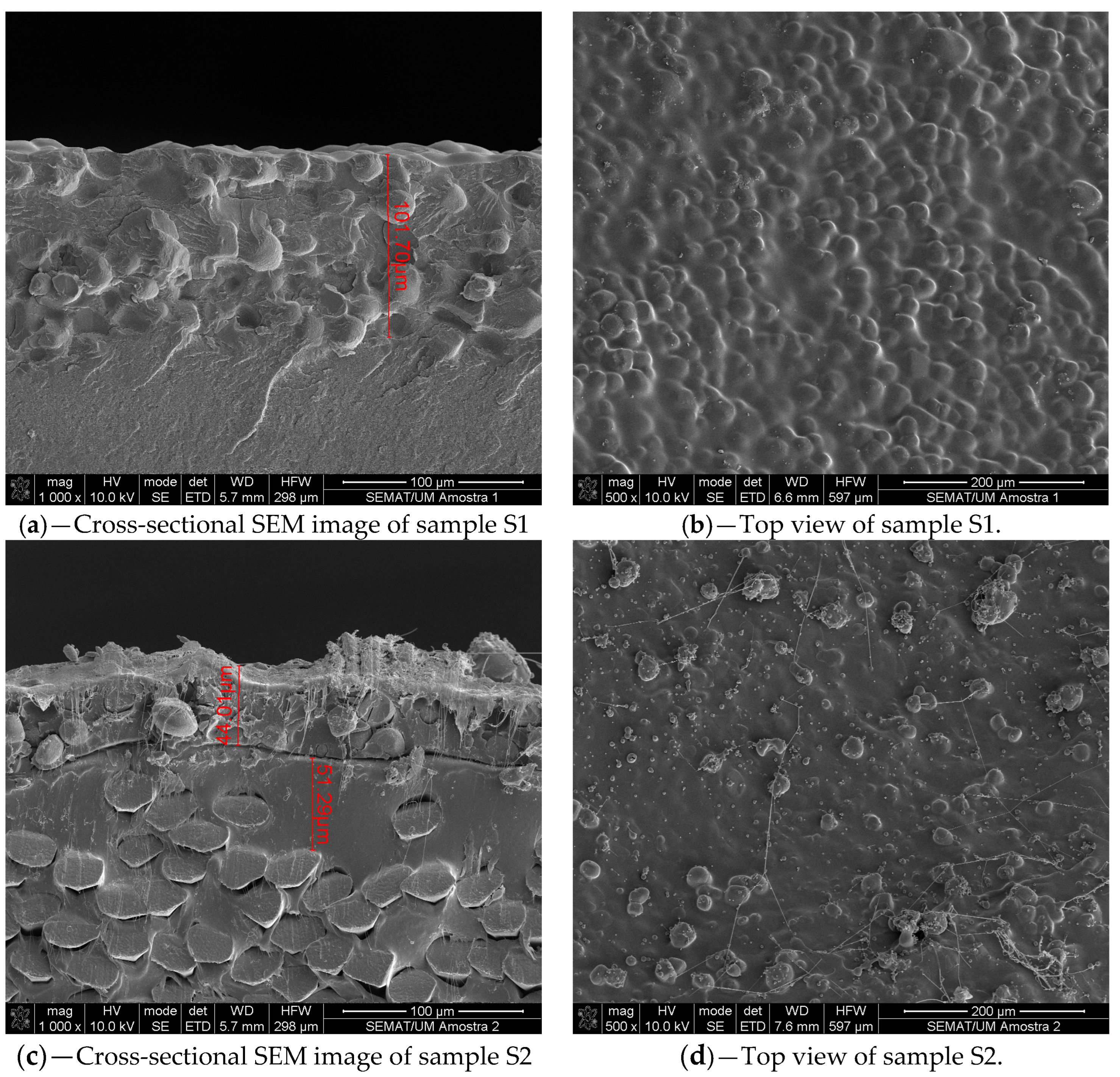


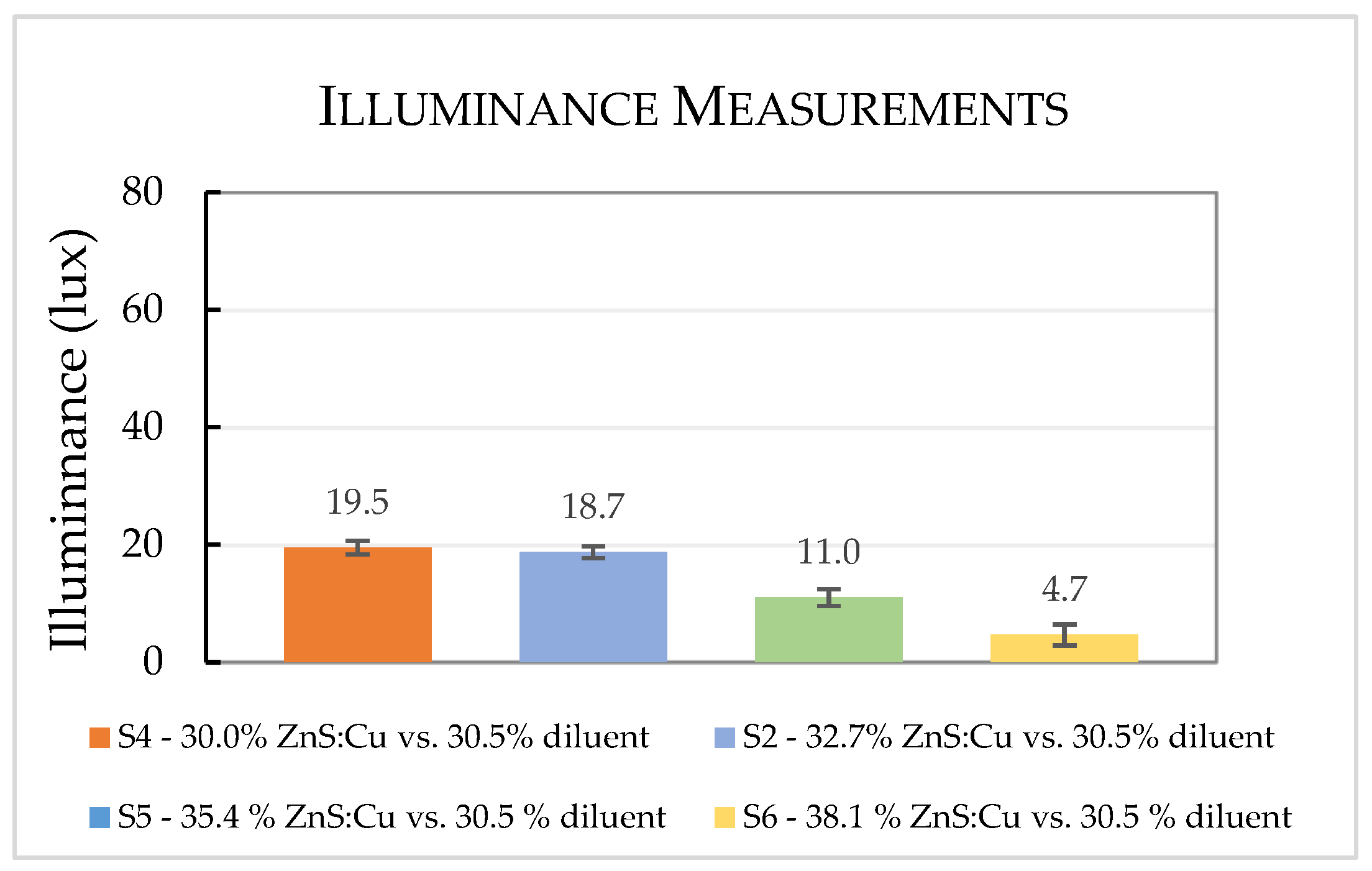


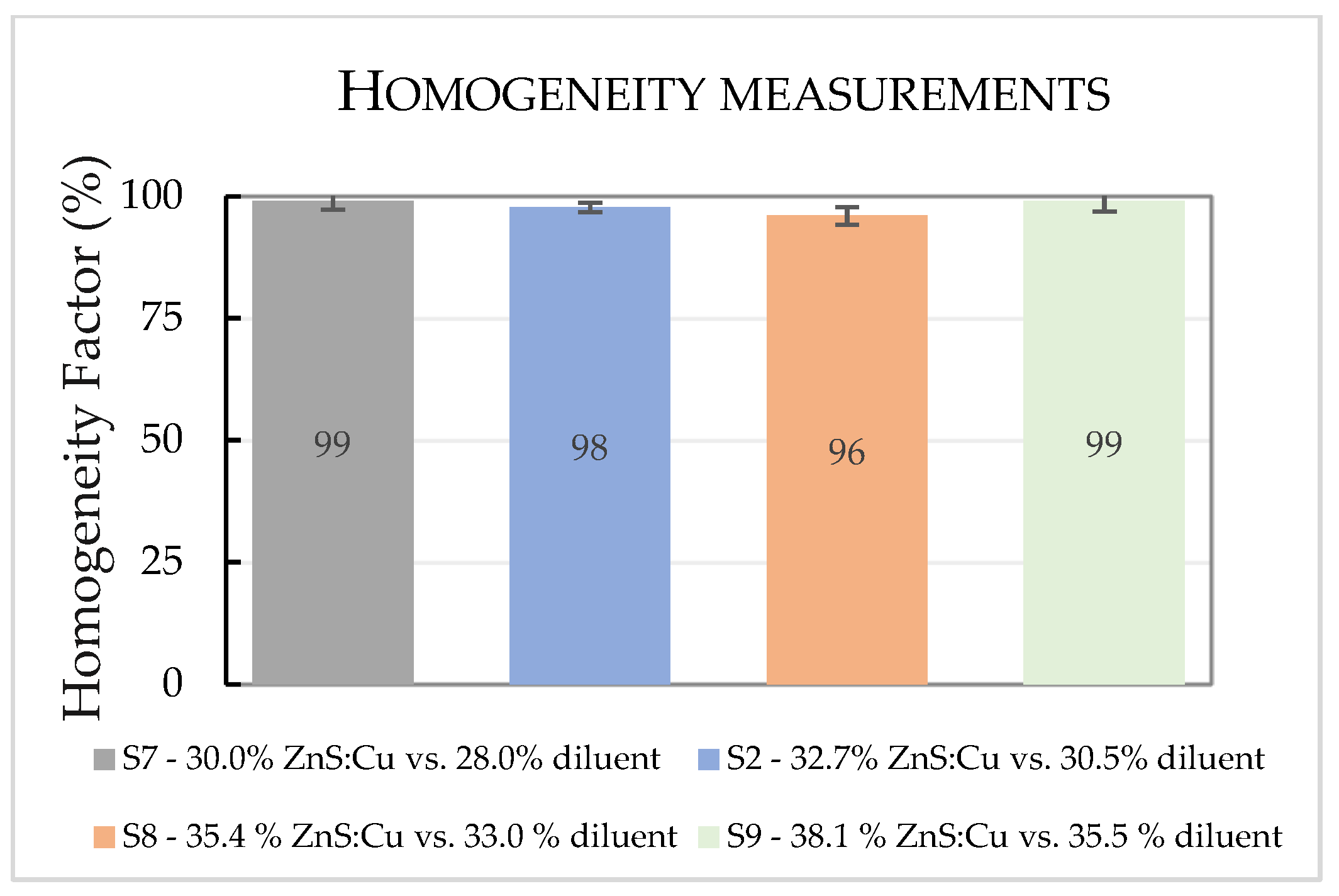
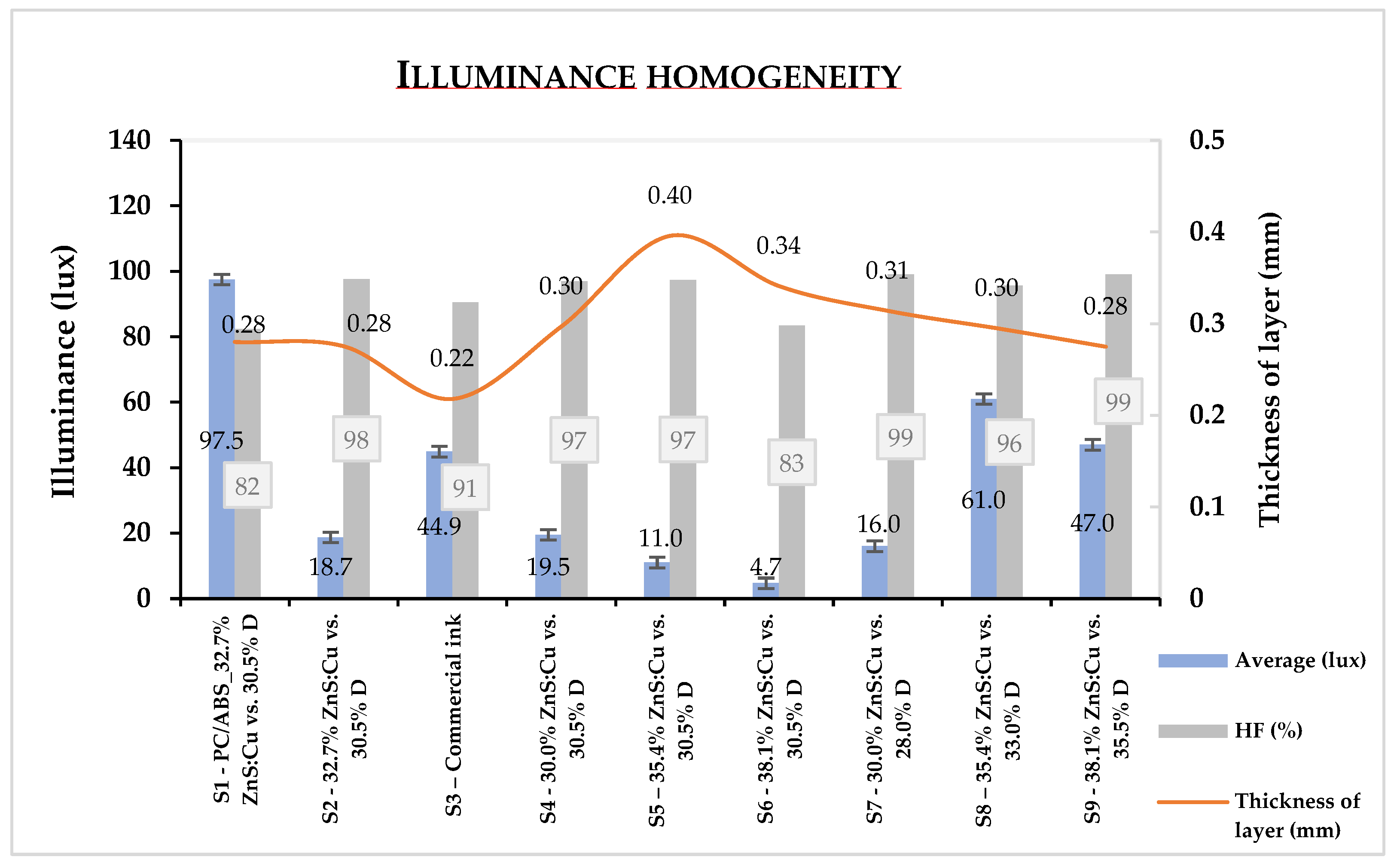
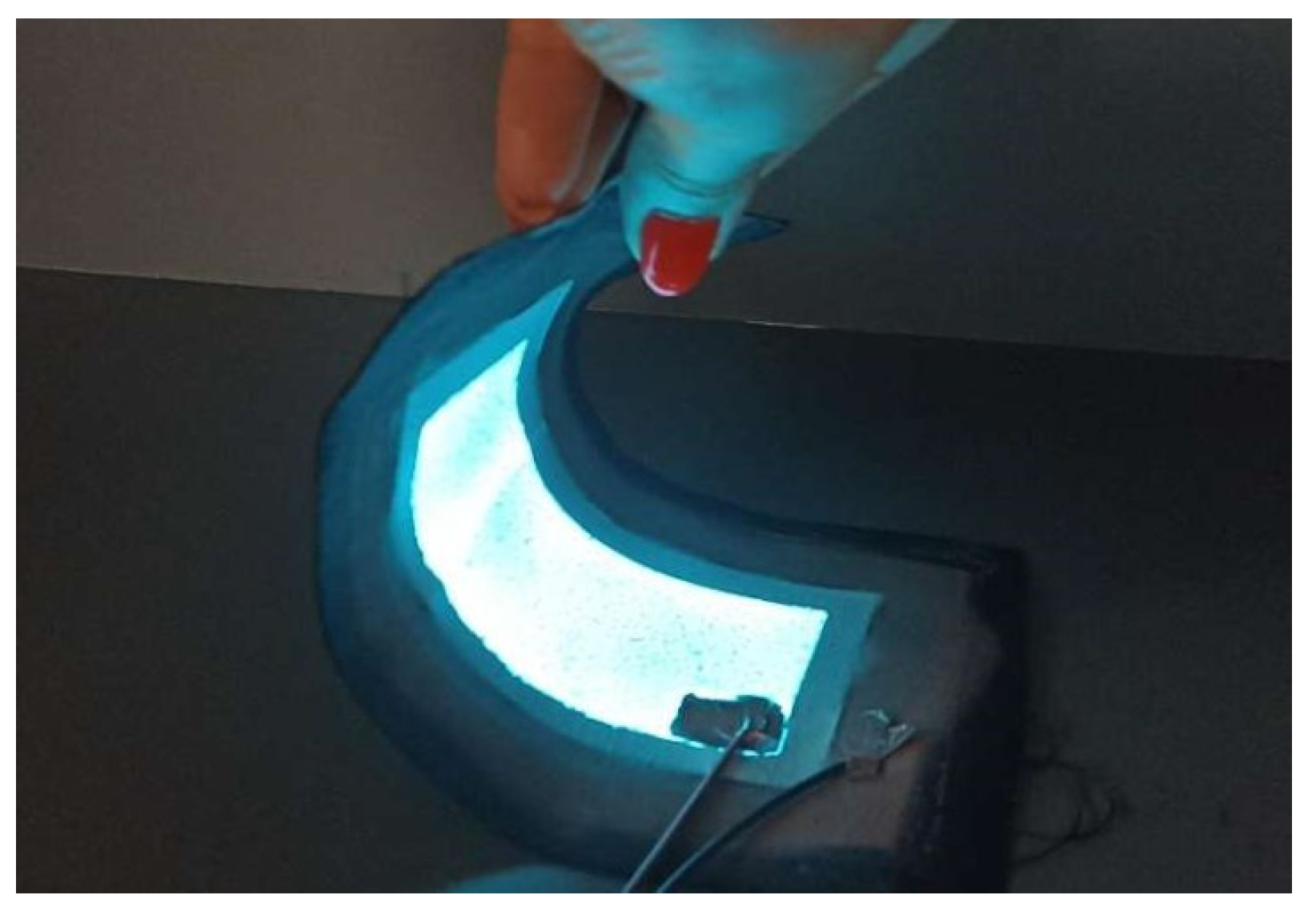
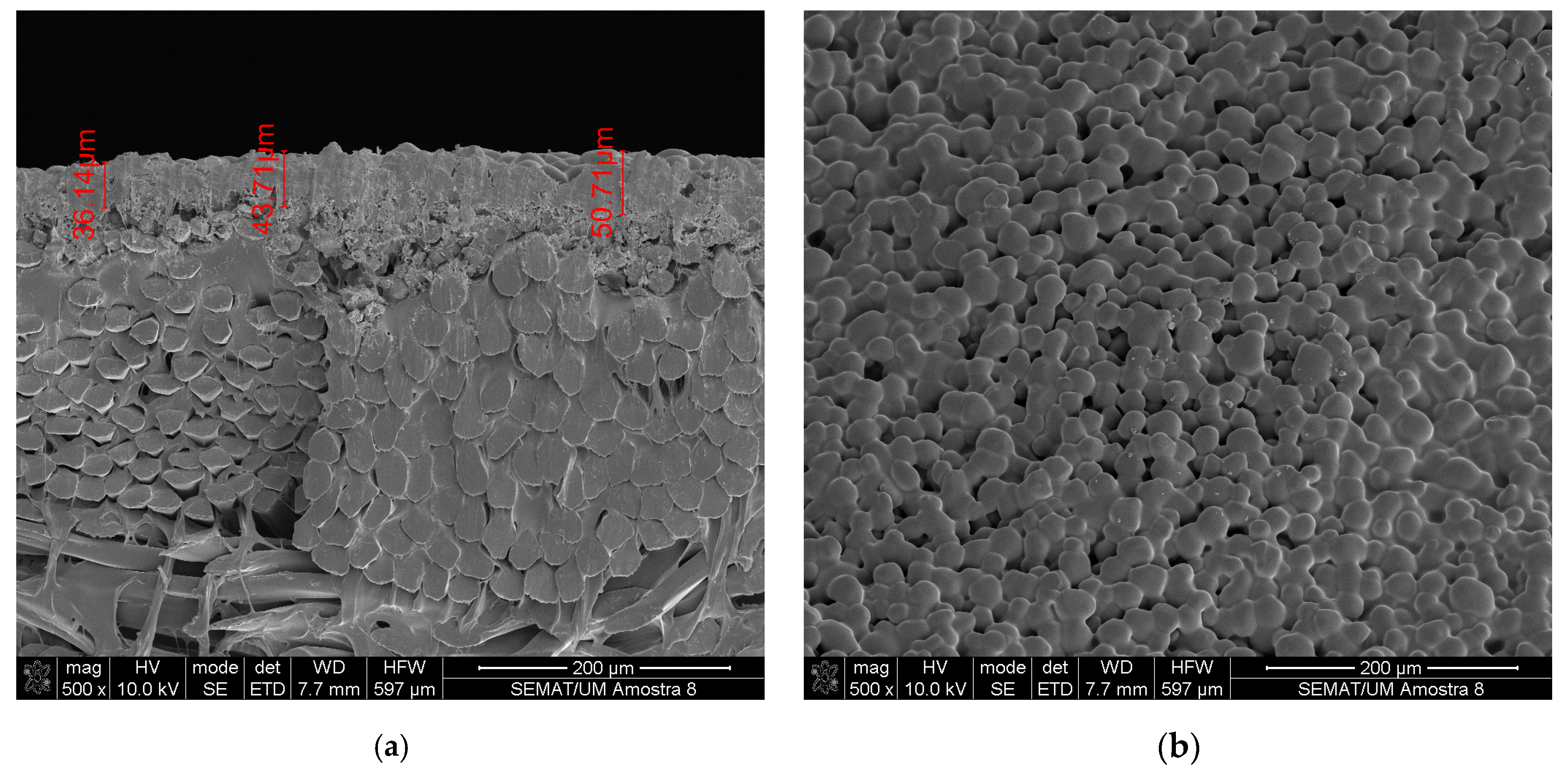
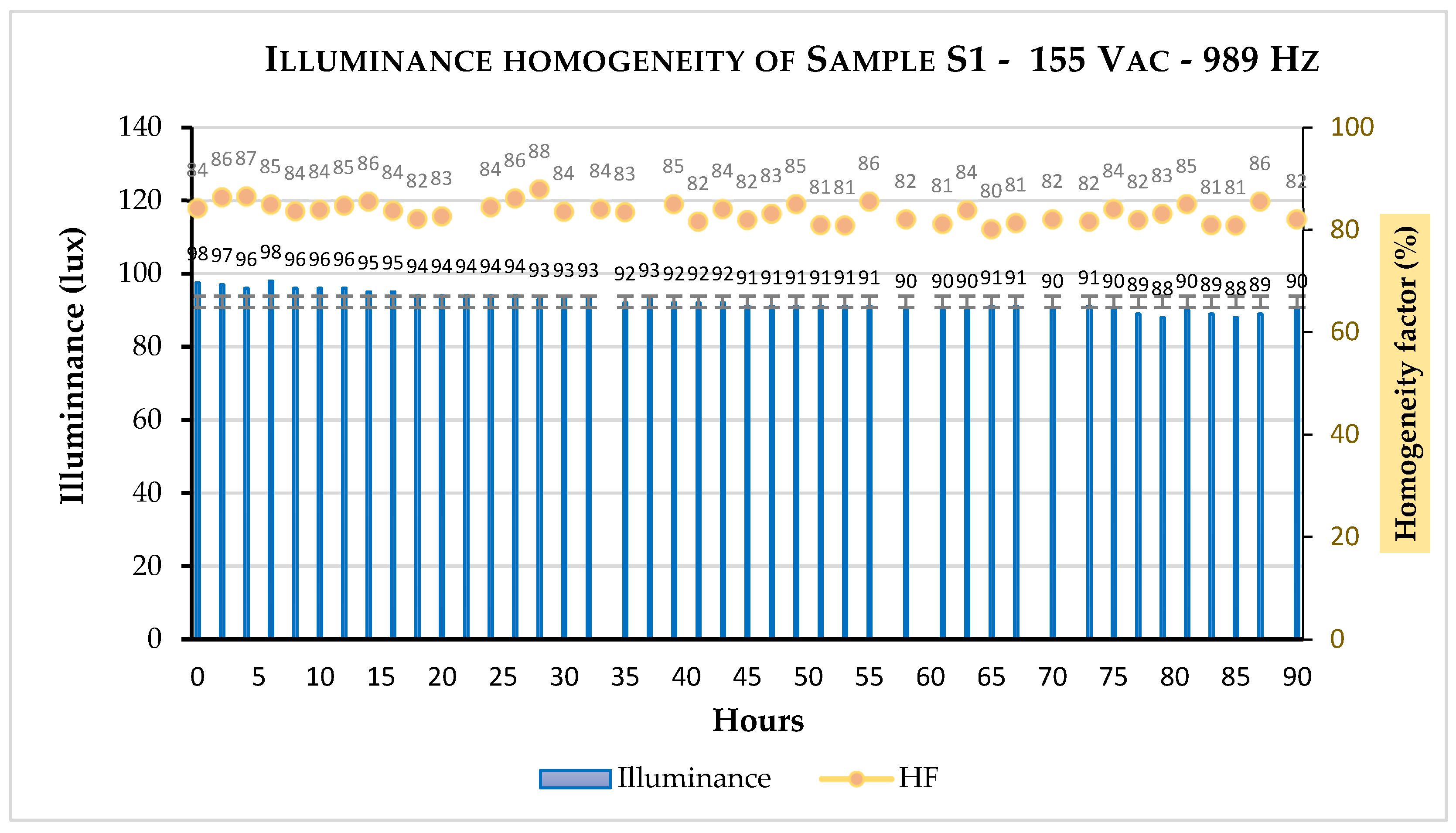
| Sample | Substrate | Phosphor Ink Composition | |
|---|---|---|---|
| ZnS:Cu (wt%) | Diluent (wt%) | ||
| S1 | Rigid PC/ABS | 32.7% | 30.5% |
| S2 | Flexible PES | 32.7% | 30.5% |
| S3 | Flexible PES | LC-B311-GR-Lumigreen * | |
| S4 | Flexible PES | 30.0% | 30.5% |
| S5 | Flexible PES | 35.4% | 30.5% |
| S6 | Flexible PES | 38.1% | 30.5% |
| S7 | Flexible PES | 30.0% | 28.0% |
| S8 | Flexible PES | 35.4% | 33.0% |
| S9 | Flexible PES | 38.1% | 35.5% |
| Element | wt% |
|---|---|
| C | 53.05 |
| O | 4.77 |
| Al | 2.36 |
| S | 4.79 |
| Zn | 35.03 |
| Total | 100.00 |
Disclaimer/Publisher’s Note: The statements, opinions and data contained in all publications are solely those of the individual author(s) and contributor(s) and not of MDPI and/or the editor(s). MDPI and/or the editor(s) disclaim responsibility for any injury to people or property resulting from any ideas, methods, instructions or products referred to in the content. |
© 2024 by the authors. Licensee MDPI, Basel, Switzerland. This article is an open access article distributed under the terms and conditions of the Creative Commons Attribution (CC BY) license (https://creativecommons.org/licenses/by/4.0/).
Share and Cite
Esteves, D.; Akgül, E.; Sanivada, U.K.; Moreira, I.P.; Bessa, J.; Silva, C.A.; Cunha, F.; Fangueiro, R. Influence of the Phosphor Layer Composition on Flexible Electroluminescent Device Performance. Coatings 2024, 14, 554. https://doi.org/10.3390/coatings14050554
Esteves D, Akgül E, Sanivada UK, Moreira IP, Bessa J, Silva CA, Cunha F, Fangueiro R. Influence of the Phosphor Layer Composition on Flexible Electroluminescent Device Performance. Coatings. 2024; 14(5):554. https://doi.org/10.3390/coatings14050554
Chicago/Turabian StyleEsteves, Dina, Esra Akgül, Usha Kiran Sanivada, Inês P. Moreira, João Bessa, Carla A. Silva, Fernando Cunha, and Raul Fangueiro. 2024. "Influence of the Phosphor Layer Composition on Flexible Electroluminescent Device Performance" Coatings 14, no. 5: 554. https://doi.org/10.3390/coatings14050554
APA StyleEsteves, D., Akgül, E., Sanivada, U. K., Moreira, I. P., Bessa, J., Silva, C. A., Cunha, F., & Fangueiro, R. (2024). Influence of the Phosphor Layer Composition on Flexible Electroluminescent Device Performance. Coatings, 14(5), 554. https://doi.org/10.3390/coatings14050554






